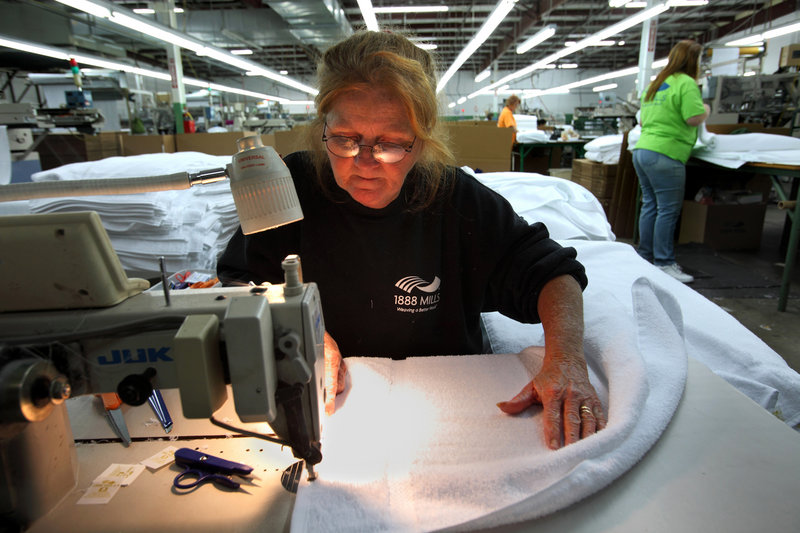GRIFFIN, Ga. – Giant machines are tearing down the old bleachery, another reminder to Chuck Smith that this old mill town doesn’t make much anymore.
Just about everyone he knows was employed at one point making, folding or bleaching towels, until the mills started to close down in the 1990s and 2000s and family members lost their jobs. Like most of this town’s residents, Smith can name all the old mills in a slow Georgia drawl.
“There was the Thomaston mill that was here, and the Dundee mill, and the Highland mill, but they tore that one down just like they did this one,” he said, watching a bulldozer push piles of metal around what used to be a factory for bleaching towels. “These mills used to employ all the people in this city.”
Recently, the town had a reason to be optimistic. Walmart announced that it will spend an additional $50 billion buying U.S.-made goods over the next 10 years. It cited 1888 Mills, which runs the last mill left in Griffin, as one company that would benefit from this pledge.
Walmart will sell 1888’s Made Here towels, manufactured in Georgia, in 600 stores this spring and in another 600 later this year, which enables the company to add manufacturing jobs.
The retailer’s effort will help businesses and “give them the nudge they need” to bring manufacturing back to the United States, Walmart U.S. Chief Executive Bill Simon said in announcing the initiative.
It’s part of a much-heralded trend of “onshoring,” in which companies including Apple, Lenovo, Otis Elevator and General Electric have said that growing logistics and labor costs overseas have motivated them to move some manufacturing back to the United States.
But if Griffin is any example, Walmart’s much-lauded pledge isn’t likely to do much to turn around a decades-long manufacturing decline here or in the rest of the country.
That’s because manufacturing has changed dramatically since it left American shores, replacing workers with machines and reducing the number of jobs that people could get right out of high school.
And as much as companies pledge they’re moving manufacturing back to the United States, they’re mostly moving just small parts of their larger global operations, to be closer to U.S. markets.
“People talk about manufacturing being a big source of job growth. It’s going to grow, but it’s not going to be a big source of total employment,” said Tom Runiewicz, principal for the industry practices group at IHS Global Insight. “It’s just a drop in the bucket.”
1888 Mills, for instance, will add just 35 jobs because of the initiative — better than nothing, but a pittance in a town of 23,000. The company will still make 90 percent of its goods in overseas factories.
“We don’t envision the entire industry going back to the United States — low-cost Asian manufacturing will still be the base for volume,” said Jonathan Simon, the CEO of 1888 Mills. “But for just-in-time service, U.S. manufacturing does make sense.”
Some 400 miles away, in North Carolina, computer giant Lenovo is doing the same thing. In October the company announced plans to open a manufacturing plant in North Carolina to make specialty personal computers for the U.S. market. The initiative will create 115 jobs, 15 of which are engineering positions. But the company also is expanding research centers in Japan and China.
“It’s a relatively small-volume facility. It’s not going to produce millions of units,” said Mark Stanton, Lenovo’s director of supply chain communications.
The United States lost 6.3 million manufacturing jobs between January 1990 and the industry’s low point in January 2010, a 36 percent decline, according to the Bureau of Labor Statistics. Since that low point, the industry has added nearly 500,000 jobs, an impressive number, but one that barely begins to offset the millions of losses.
A walk through the spacious 1888 factory in Griffin shows why job gains have been slow, despite some onshoring.
Machines spin threads of cotton into yarn, a process once done by hand; they weave the yarn into thick rolls of fabric, cut the fabric into towels and sew the hems. Where a whole factory was once needed to bleach and color the towels, a Rube Goldberg-like machine does that work with minimal labor; another machine dries the towels.
“It’s all automated,” Douglas Tingle, founder of 1888 Mills, said on a tour of the factory. “Some of this is the latest technology advancements.”
That automation is part of the reason that although labor costs are higher in the United States than in other countries, it can make sense to make towels and other products here.
But there are other reasons as well. If 1888 needs to make changes to towels, it can get the finished product to Walmart more quickly from Griffin than it could from China.
The rising price of oil is increasing shipping costs, and again could provide some cost savings for locally manufactured products.
One characteristic of those new manufacturing jobs is that they are rarely unionized. Companies tend to locate their operations in Southern right-to-work states and in more rural areas where people are “maybe a little more appreciative of the job,” said Harry Moser, founder of the Reshoring Initiative, which helps companies looking at bringing manufacturing back to the U.S.
Send questions/comments to the editors.



Success. Please wait for the page to reload. If the page does not reload within 5 seconds, please refresh the page.
Enter your email and password to access comments.
Hi, to comment on stories you must . This profile is in addition to your subscription and website login.
Already have a commenting profile? .
Invalid username/password.
Please check your email to confirm and complete your registration.
Only subscribers are eligible to post comments. Please subscribe or login first for digital access. Here’s why.
Use the form below to reset your password. When you've submitted your account email, we will send an email with a reset code.